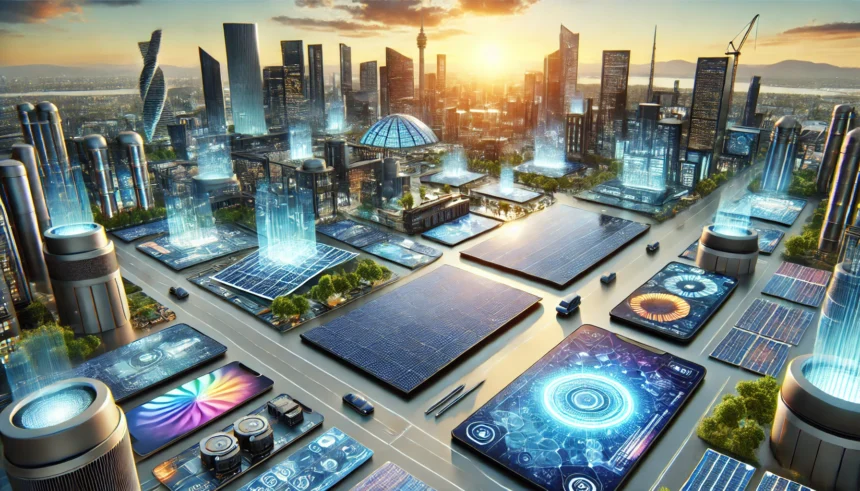Technology is a big part of our lives, and XCV panels are making a huge impact. With limited natural resources, people in the USA are turning to XCV panels because they are efficient and versatile. Finding alternatives like XCV panels is crucial as natural resources become scarce and expensive.
What are XCV Panels?
XCV panels are advanced solar panels made up of connected photoelectric cells. These cells turn sunlight into electricity, which is then stored in batteries for later use. These panels have a smart interface that makes it easy to control electronic devices, making them perfect for large systems and industrial use.
The panels use OLED and quantum dot technology to create high-quality images. OLEDs (Organic Light-Emitting Diodes) are thin, flexible materials that produce deep blacks and vibrant colors. Quantum dots are tiny crystals that emit different light colors, improving brightness, contrast, and color accuracy.
How Do XCV Panels Work?
XCV panels have several layers:
- OLED Backlight: This layer provides light for the panel.
- Quantum Dots: These act as a color filter, turning white light from the OLED layer into different colors.
- Photovoltaic Cells: These cells convert sunlight into electricity, which is stored in batteries for use later.
Different voltages applied to the quantum dots can emit different colors, allowing for dynamic color changes and optimization.
The panels capture sunlight through photovoltaic cells, convert it into electricity, and store it in batteries. The OLED layer provides backlighting, while the quantum dots filter the light to produce vibrant and accurate colors. This combination allows for high-quality display capabilities with advanced control features.
Features and Specifications
XCV panels offer top-notch graphics, multi-touch gestures, and an intuitive, user-friendly interface. They clearly display large amounts of data using graphs, charts, and widgets.
Users can customize the XCV panels’ layout, design, and functions to meet their needs. These panels support multiple protocols, such as MQTT, OPC-UA, and Modbus, making them compatible with various devices and systems. They also offer strong security features to prevent unauthorized access and protect sensitive information.
Benefits of XCV Panels
XCV panels are incredibly bright, achieving over 10,000 nits, much higher than standard HDR displays. This makes them perfect for use in bright environments, like outdoors. They also have a contrast ratio of 1,000,000:1, providing clear, detailed images in dark and bright scenes.
XCV panels cover over 99% of the DCI-P3 color spectrum, delivering consistent and natural colors. This makes them ideal for uses that require precise color accuracy, like digital cinema and HDR content.
XCV panels use less than 10 watts per square meter, making them ten times more efficient than standard HDR LCD screens. This low power consumption saves energy and reduces environmental impact, extending the battery life of portable devices.
Applications of XCV Panels
XCV panels improve smartphone visual experience with high resolution, contrast, brightness, and color accuracy. Their lightweight design and low power use ensure a long-lasting user experience.
XCV panels provide superior viewing with high resolution, contrast, and brightness for laptops and monitors. They are lightweight and consume minimal power, making them practical for everyday use.
XCV panels deliver a cinematic experience in TVs and projectors with high-quality displays and low power consumption. Their thin, lightweight design is perfect for modern home entertainment systems.
XCV panels are also great for VR and AR devices, offering high-quality graphics, low latency, and a compact, comfortable design. Users can enjoy an immersive experience without issues like motion sickness or high power use.
Future of XCV Panels
Currently, XCV panels are just starting to make an impact, but they promise to revolutionize display technology. With ongoing advancements and future developments, these panels will likely become a key part of modern technology, offering better efficiency, display quality, and a wide range of uses.
Bottom-Line
XCV panels are a groundbreaking advancement in display technology, combining OLED and quantum dot technologies to deliver superior performance. Their high-quality graphics, energy efficiency, and wide range of applications make them a valuable asset in today’s tech-driven world. As they continue to evolve, XCV panels will play a crucial role in shaping the future of digital displays.
(FAQs)
How long do XCV panels last?
XCV panels typically last around 25 to 30 years, similar to traditional solar panels. Proper care and maintenance can provide consistent performance for a long time.
Can I add XCV panels to my current solar system?
Yes, you can integrate XCV panels into your existing solar energy system. They are designed to work with many setups, making upgrading and improving your current system easy.
Are XCV panels durable?
XCV panels are very durable. They are built with advanced materials that can withstand harsh weather conditions, making them a reliable choice for long-term use.
Do XCV panels work in cloudy or low-light conditions?
Yes, XCV panels efficiently capture and convert light even in low-light conditions. They are designed to perform well throughout the day, even when sunlight is limited.
How much maintenance do XCV panels need?
XCV panels require minimal maintenance. Regular cleaning to remove dust and periodic inspections to check for any damage are usually enough to keep them working well. Their advanced design means less frequent maintenance compared to traditional panels.












